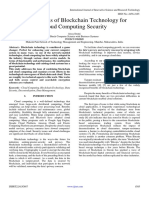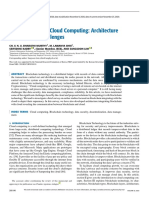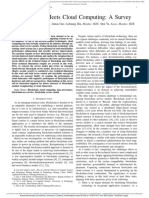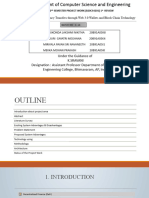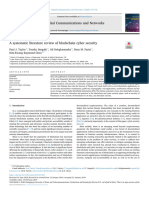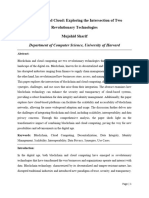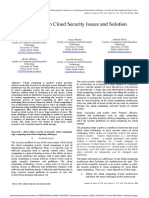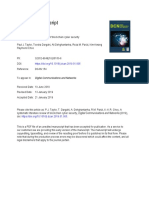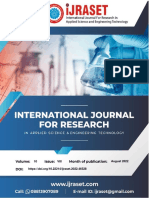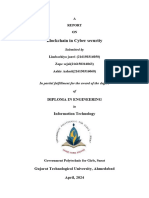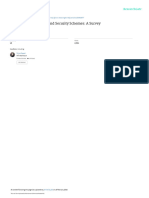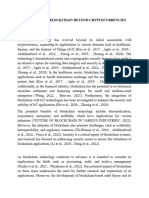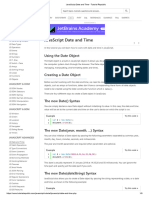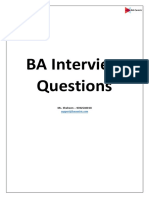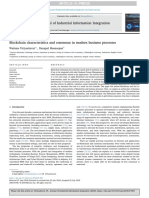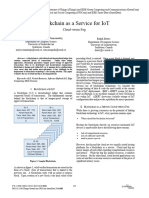Application of Block Chain in Cloud Computing
Uploaded by
superbadgetrailApplication of Block Chain in Cloud Computing
Uploaded by
superbadgetrailInternational Journal of Innovative Technology and Exploring Engineering (IJITEE)
ISSN: 2278-3075, Volume-8 Issue-12, October 2019
Application of Block chain in Cloud Computing
Simanta Shekhar Sarmah
Abstract: Blockchain technology is recent and eminent The transaction process via blockchain concept are mainly
financial technology that completely transform the business done via authentication process, where the customer
transactions. It’s a decentralized network, that support and performs virtual transactions. This block is periodically
employ variety of cryptography models. This robust and flexible
updated and reflected in the electronic money transaction
secured transactions is being integrated with another eminent
computing paradigm, cloud computing. In this paper, we make details to share the latest transaction detail block. The rest of
an attempt to review about the application of blockchain in cloud the paper is organized as follows: Section II presents the aim
computing system. Firstly, the concept of blockchain is briefly and objectives of the research; Section III presents the
discussed with their advantages and disadvantages. Second, the literature review of cloud computing systems and finally,
concept of cloud computing is briefly demonstrated with concludes in Section III with possible research gaps.
blockchain technology. Finally, prior papers are reviewed and
presented in tabular form. It dictates that the research gaps, still,
pertains in field of blockchain based on cloud computing systems. II. RESEARCH AIM AND OBJECTIVES
This paper assists the upcoming researchers in this field for The purpose of the study is to identify the purpose of
designing novel secured models.
blockchain technology in the field of cloud computing and
Keywords: Blockchain technology, Cloud computing,
Research gaps, Security and the computational cost.
to identify the potential threats and challenges in the
application of blockchain technology when applied in the
I. INTRODUCTION area of cloud computing. The following objectives are stated
below:
Recent developments made in information processing To evaluate the digital brand marketing strategies in the
systems has attracted the common users for better storage of context of national Tourism brand marketing.
their data. The present field, cloud computing is employed To identify the scope of blockchain technology and
as utility model for cloud users. Depends on their premises, its application on the area of cloud computing.
the cloud users can access, share (or) transacts the data, at To identify the security significance of blockchain
anywhere, anytime. It indirectly implies that cloud users do technology on its application to cloud computing.
not have direct control on resources, after uploading to the
To analyse the latest solution in the context of
cloud server. Based on terms and conditions, the cloud
security aspects by maintaining confidentiality,
provider offers services on as-is and as-available form [1].
integrity and authentication of public information.
As we dive deeper into “information age’, an immense
growth can be witnessed in terms of volume, velocity and
III. LITERATURE REVIEW
variety of data on internet. Data can be originated from
multiple types of sources such as mobile devices, sensors, This section deals with the literature related to the
archives and the social networks. This kind of data concept and algorithms of blockchain technology and cloud
explosions poses a serious research questions like ‘how to computing frameworks. The section encounters the various
efficiently and optimally administer large amounts of data theoretical framework and algorithms in the context of
and recognize the new preservation ways of unlocking blockchain technology a cloud computing.
information. Millions of transactions are being generated A. Blockchain technology:
that composes of sensitive heterogenous and homogenous
This section demonstrates the generic model and the
data that do not compromise the quality of service in end
working process of blockchain model. Generally, the
users [2]. Challenges persists in information processing
blockchain architecture is developed as a reference
units supports variant financial markets for development of
architecture for cloud computing, edge computing and fog
next generation financial technology for secured use of
computing. It shall also be merged with another large-scale
network technology and the user communication. In order to
distributed model. In present days, it’s been combined with
deal with financial security, blockchain technology has been
cloud system to ensure better secured system.
introduced. It is defined as public ledger network that
provide better secured online transactions. The concept of Origins of Blockchain: Blockchain technology is a
blockchain sort of distributed architecture that make use of
model introduced since, 2008 [3]. The first cryptocurrency that make use of cryptographic signed transactions [4]. It operates in block-
blockchain based approach is ‘bitcoin’. wise manner. Each block is linked with cryptographic
systems. Authenticity of the transactions should validate
and evaluated at each single point of failure. It employs
several features of the Peer to Peer (P2P) model. This
model does not incur the broker fees for authorizing the
Revised Manuscript Received on October 4, 2019. transactions. Since, this blockchain process ensures robust
* Correspondence Author
Simanta Shekhar Sarmah*, Business Intelligence Architect, Alpha
Clinical Systems Inc, USA.
Retrieval Number: L3585081219/2019©BEIESP 4698 Published By:
Blue Eyes Intelligence Engineering
DOI: 10.35940/ijitee.L3585.1081219
& Sciences Publication
Application of Block chain in Cloud Computing
and scalable security to its end systems, the growth components, namely,
of blockchain technology is inclined. The hackers also find Block number (or) block height.
hard to exploit the vulnerabilities to the transactions Hash value of present block
systems. Thus, the transactions are easier and open access. Hash value of previous block
The below fig.3.1 presents the basic components of Merkle tree root hash
blockchain P2P architecture. Timestamp
Hashes: It is one of the main components in Size of the block
blockchain model which adopts different use cases. Its Transactions list in block
main task is to encrypt the data presented in block. It Processes in blockchain: Most of the nodes in
computes any size of data. The changes made in input can blockchain networks owned by different organizations.
depicts the output with that specified changes. SHA-256 Depends on ledger content, the nodes are communicated.
algorithm is being widely used for many real-time By doing so, the node agreement issue degrades the
applications. performance of the system. The blockchain receives
transaction requests, which are submitted by users, to
perform the operation it has been designed for. As a result
of the execution of such a transaction, one or more ledgers
store a record of the transaction which will never be
modified or deleted. With this process, the immutability of
the blockchain is achieved.
Fig.3.1. Blockchain technology in P2P architecture
Ledgers: It composes of set of transactions. Each
node has a copy of transactions i.e. Ledger. In conventional
model, pen and paper are widely used for maintaining the
ledgers. The same concept has been applied with adoption
of new computing technologies. Hence, a centralized
ledger is being used with some demerits, such as, single
point of failure i.e. Sudden data loss & centralized Fig.3.2 Generic blockchain model
committed transaction verifies with third party agent.
Blocks: Each node in blocks receives a transaction Blockchain security: It is a kind of network
id given by end users. With this transaction index, the environments where transaction data and the parameters
further operations are proceeded until the process ends. The are close to business logic. Asymmetric Key Cryptography
mid-operations will not save in transactional process. A is widely used for blockchain transactions. Block of keys,
transaction pool, a queue is maintained for all committed viz, public and private key are used for entire transactions.
transactions. Mining nodes are responsible for updating the Private key is used for validating the signatures on
transaction process at every phase. Hence, a block transactions. Public key checks generated signature by
composes of full set of transactions. The invalid private key.
transactions are rejected by blockchain mechanism. This
B. Concept of Bitcoin:
method confirms the rigidness of data as generated hash
would dramatically change by a change in single bit of the Bitcoin can be defined as an electronic cash system
block. In addition, a copy of the hash of every block is where each electronic coin is a chain of digital signatures.
shared among all the nodes in order to improve security. Each owner communicates by digital signing and then
This system prevents any change since every node can transfer the coin based on hash transaction of current and
check if the hash matches. The fig.3.2 presents the model previous history. Depends on their ownership, a payee can
of blockchain system which operates using merkle tree verify the signatures [5]. The fig. 3.3 explain the concept of
structure. bitcoin.
The blocks in blockchain model composes of following The working process of
bitcoin is explained as
Retrieval Number: L3585081219/2019©BEIESP 4699 Published By:
Blue Eyes Intelligence Engineering
DOI: 10.35940/ijitee.L3585.1081219
& Sciences Publication
Application of Block chain in Cloud Computing
follows: authorization system has become much harder as the
protection and auditing of these systems are managed
a) Fresh transactions are initially broadcast to all separately.
nodes. D. Parameters in blockchain technology:
b) The fresh transaction is being collected by each
The parameters involved in success of blockchain
node in block.
technology, are:
c) Proof-of-work on every block should assigned.
E-Cash and its security: e-Cash is the new concept
d) When proof-of-work is been find by node, then
that makes a revolution in e-commerce world. It’s just
broadcast message send to all nodes in that block.
replaces the paper and coin of the old systems. Credit card
e) Only valid transactions are processed, rather than
is one of the best e-cash systems. This system requires a
spent. trusted environment with merchants and agents. Bank or
f) Nodes accept the blocks based on their hashing issuer stores the E-cash and during the making of a
facilities. payment, consumer needs to request for it.[7]. Different
from online, off-line e-cash is kept by consumer in a devise
such as smart card or other type of token. Each of this
implementation can be classified as identified (traceable) or
anonymous (untraceable). By identified implementation, it
means each transaction needs verification and validation
from third party such as bank. This implementation offers
better security because it uses encryption and digital
signature to secure and authenticate the E-cash message
respectively. The fig. 3.4 presents the workflow of e-cash
processes, in which entities like bank, consumer and the
merchant should be mutual trusted environment.
Fig.3.3 working process of bitcoin
C. Authentication- Insight on cloud computing:
An incentive and attractive computing services
delivered by the cloud computing via resource pooling and
virtualization techniques. Security as a service is a new Fig.3.4. Workflow of e-cash
concern in cloud computing paradigms. An organization can
offers many application services to the end-users. E-mail Access control: It’s a kind of systems that facilitate
and the web servers are the best instances of application security to the data stored. The resources are valuable in
service providers. The company may possess certain terms of data, services and the computational systems. In
boundaries on their services, all services should adopt by the order to create trusted environment, the entity should hold
authorized clients. This means that the client should have different access rights. Some scenarios require that access
security context for each application server and log in before rights can be transferred from a subject to another for some
it can consume any service [6]. Similar situation can be seen reasons. For instance, a user could sell its access right to
when a user accesses resources in various security domains. another user [8]. Similarly, an employee of an organization
It is not considered as an effective solution in terms of who needs to perform a required computation on a Virtual
security, system coordination and management standpoint if Machine deputes the task to another employee who also
authentication requires several security credentials. During needs to access the same machine.
the cloud migration, organizations encounter similar issues E. Integration of Blockchain in cloud computing and its
as well. Variant entities are presented to acquire those security:
services, and, thus, a proper security mechanism is required. Cloud computing composes large networks of virtualized
As services grows, the management of access control services, namely, hardware resources and the software
becomes complex and expensive. Most of the applications resources. Any sort of services belongs to data centres and
focus on functionality of system and the organization value. known as data farms [9]. The fig. 3.5 demonstrates the P2P
Thus, a single security policy management ensures better based cloud architecture.
authorization systems with flexible and scalable. Besides,
changing a policy becomes very simple because of a single
location for policy management. Compromise of
Retrieval Number: L3585081219/2019©BEIESP 4700 Published By:
Blue Eyes Intelligence Engineering
DOI: 10.35940/ijitee.L3585.1081219
& Sciences Publication
Application of Block chain in Cloud Computing
function of the cloud systems in dynamic environment.
a) In view of security: From user, the data are
hidden and stored in data centres. Thus, the
transactional activities should be assigned with
tuning purposes. It means that the cloud service
allows their customers to have control over the
locations in which their data is stored and
processed.
b) System resilience and fault tolerance: The
system should capable of finding the alternate
node, if any node fails in network. Thus, a node
Fig.3.5. P2P based cloud architecture replication mechanism in data centres and use
There are two methods available for integrating the of multiple software applications.
c) Security towards blockchain improvements:
blockchain in cloud systems:
Software should centrally assign in distributed
a) Integrating blockchain with cloud for facilitating
cloud environment and the use of multiple
enterprise networks like storage, replication
software applications.
and access to transactional database.
b) Integrating with security concepts between task, F. Research Gap:
user, and data management in clouds. The research gap assists for finding the scope of the
The following are the challenges and requirements research study. The review study is given in tabular form for
involved in support of cloud based blockchain transactions better convenience.
[10]. The transactions involved in blockchain networks are
enormous in nature. Elasticity and scalability are the main
Sl. No Paper title Methods Gaps Results
1 Proof-of-Work consensus Statistical method with POW consensus Longer duration is required for It takes less time for
approach in Blockchain approach for cloud and fog computing. In data access. converging the solutions and
Technology for Cloud and addition to, expectation maximization and the It enhanced the consensus delay configures all mathematical
Fog Computing using polynomial matrix factorization by misclassified data blocks models.
Maximization-
Factorization Statistics
2 A Blockchain Future to This survey paper has analysed IoT datasets They discussed about the future They discussed reliability
Internet of Things and its impact over blockchain mechanism of blockchain by identifying the and the data distribution over
Security: A Position since 2016 till present. possible threats. The system public network.
Paper enhanced the data intervention.
Possibility of hardware and
software are being easily
compromised.
3 Auction Mechanisms in They suggested an auction-based market When the level of blockchain Winner selection problem is
Cloud/Fog Computing models that efficiently allocates the resources mining increases, the blockchain framed and obtained an
Resource Allocation for to the users. A decentralized management developer gradually smaller the optimal solution. Depends
Public Blockchain system was introduced. It consists of two marginal gains. on miner selection,
Networks bidding schemes, namely, constant demand Though, they prevented the individual rationality and the
scheme and the multi-demand scheme which double spending attacks, because truthfulness at guaranteed
achieved the optimal social welfare. of adverse effect of block lower bound.
broadcasting process.
4 Controllable and They developed controllable blockchain data The model has limited impacts Security and the utility of the
Trustworthy Blockchain- management for cloud systems. Data is being over efficiency of the document cloud environment were
based Cloud analysed in terms of bilinear pairing. selections. improved by trustworthy
Data Management The encrypted requests on parameters.
modified document incurs higher
computational cost.
5 Integrated Blockchain and They studied the integrated blockchain and Mobility of the edge computing It enhanced the security of
Edge Computing edge computing systems which faced the pushes the cloud resources and the systems during network
Systems: A Survey, Some challenges of decentralized environment. the services for denial of edge. server partitioning and the
Research Issues and It incurs excessive overheads self- organization schemes.
Challenges during scalability analysis.
Retrieval Number: L3585081219/2019©BEIESP 4701 Published By:
Blue Eyes Intelligence Engineering
DOI: 10.35940/ijitee.L3585.1081219
& Sciences Publication
Application of Block chain in Cloud Computing
6 ProvChain: A Blockchain- A decentralized and trusted cloud data It failed to develop the trusted It improved the security,
based Data Provenance provenance architecture using blockchain environment. transparency and the data
Architecture in Cloud technology was suggested. ProvChain is When file size increases, accountability.
Environment with architecture developed for collecting and overhead increases the
Enhanced Privacy and verifying the data provenance. computational complexity.
Availability
7 Hierarchical Edge-Cloud They presented a two-layer computation Different communication delays With the help of
Computing for Mobile offloading model that comprised the service of alter the security model of the reinforcement learning, the
Blockchain Mining Game edge computing and the cloud computing. environment. blockchain protocols
Two case study was analysed, a fixed miner Maximized the profit of the discarded the administration
number and the dynamic miner number. limited resources. of blockchain’s security and
privacy.
8 Secure data storage based Combing blockchain with regeneration coding Analysis on redundant hash Security and reliability of the
on blockchain and coding was suggested to enhance the security and values changes the integrity of coding environment is
in edge computing reliability of data stored under edge the data. ensured.
computing. Shortcoming of bandwidth Ensured the integrity of the
decreased the value of single data.
cloud server.
9 FogBus: A Blockchain- FogBus is the mechanism introduced which It failed to support services for The simplified process
based Lightweight facilitated end-to -end IoT fog-cloud both users and the providers. reduced the cost and
Framework for Edge and integration. This blockchain technology Though, a centralized scalability of the data.
Fog Computing ensures the sensitivity of the data. programming module is Based on situation, the data
incorporated, the task of applying are communicated.
security features dislike the
dealing with diverse applications
10 Blockchain-Based Public They employed a certificateless public Though it’s a certificateless They analysed the
Integrity Verification for verification scheme against procrastinating photography, the performance of computational overhead and
Cloud Storage against auditors using blockchain technology. It auditors during verifications is of communication overhead.
Procrastinating Auditors demands the auditors for verification process poor. Likewise, the computational
via blockchain transaction. If auditor is being compromised, costs on server side is not
the chance of attack rate is of wiser due to its poor auditing
high. services.
11 SmartProvenance: A They suggested blockchain as a trustworthy Allocation of each updated The use of randomized
Distributed, Blockchain platform for data provenance collection, document consumes higher voting
Based Data verification and the management. They also computational costs, because it reduces the centralization of
Provenance System studied smart contracts and the open maintains the old memory of the verification process.
provenance models for interpreting the data documents. Therefore,
trails. Utilization of public address there is no need for a
reveals identity of the process. physical verifier as the
verification script
verifies the changes before
voting on the change
12 A Blockchain-enabled They developed a crowd intelligence model It created excessive latency Eliminated the network
Thrustless Crowd- for platform, workers and the task publishers. fluctuation. It doesn’t reduce the congestion.
Intelligence They resolved the trust issue between location uncertainty. It doesn’t It also maximized the strong
Ecosystem on Mobile publisher and the workers by reward-penalty reduce the worker shortage issue. nash equilibrium that
Edge Computing models. interests the edge servers.
13 A Blockchain Enabled Potential impacts of blockchain technology To develop a learning agent, a They ensured
Cyber-Physical System and the realization of Cyper-Physical greater number of training data is interoperability, data
Architecture for Production Systems (CPSS) with three level required. integrity, security and the
Industry 4.0 architecture was developed. privacy.
Manufacturing Systems
14 Permissioned Blockchain They introduced a Permissioned Blockchain Covert channel attack is a type of It avoided the energy related
and Edge Computing Edge Model for Smart Grid Network model adversarial approach that uses attacks.
Empowered Privacy- that resolved smart grid, privacy protections latency time to leak critical
preserving Smart Grid and the energy security. information. It must be focussed
Networks using top-up and bottom-down
approaches.
15 Cloud-assisted secure They framed a secure cloud assisted e-health The collusion between data They analysed
eHealth systems for systems which eliminated the illegal server and its corresponding communication overhead
tamper-proofing modification. transactions are processed as and computational overhead
EHR via blockchain blockchain. with reduced computational
Absence of central authority time.
request multiple tokens creates
non-trusted environment.
16 CKshare: secured cloud- Secured Cloud-based knowledge is suggested Due to the immutability of the The security of the system
based knowledge-sharing for private and blockchain technology. It’s a blockchain, its labelling is was tested.
blockchain for injection redesign knowledge sharing platform that has critical. This will help
mold redesign its own privacy and data format requirements. in reducing the risks of fake
Similarly, retrieval mechanism developed knowledge
using k-nearest neighbour.
Retrieval Number: L3585081219/2019©BEIESP 4702 Published By:
Blue Eyes Intelligence Engineering
DOI: 10.35940/ijitee.L3585.1081219
& Sciences Publication
Application of Block chain in Cloud Computing
17 Privacy-preserving A consortium blockchain oriented approach Analysis on fake accounts The developed account
Energy Trading Using was studied for privacy leakage problem. The creation is not examined. generation and bound
Consortium Blockchain in model mines the behaviour users for privacy detection algorithms
Smart Grid modelling validated the trust between
user and service providers.
18 SecLaaS: Secure They introduced secure logging as a service Usage of bloom filter process They analysed past log of
Logging-as-a-Service for model that provides access to forensic for like probabilistic data structure generation of data
Cloud ensuring confidentiality of the users. Based on consumes higher time for accumulators. Average
Forensics past logs, the dishonest behaviours are membership verification. execution time were
analysed. analysed for all sorts of
CPU.
19 Secure and Reliable IoT They developed an IOT framework which The SDN network achieves They achieved high
Networks Using Fog serves both fog layer and the edge layer for lower system performance in reliability and availability.
Computing with nodes with distributed controllers and resource terms of network management,
Software-Defined constraints. flexibility and latency
Networking performances. Moreover, a data
and Blockchain offloading algorithm was not
organized and managed the
offloading scheme.
20 Blockchain Radio Access They introduced a Blockchain radio access The secured multi-party They analysed throughput vs
Network (B-RAN): network (B-RAN) architecture and developed computation can be further traffic load, throughput vs
Towards Decentralized decentralized, secure, and efficient incorporated block size and latency vs
Secure Radio Access mechanisms to manage network access and to avoid unauthorized access of security and proved better
Paradigm authentication among inherently trust less sensitive data but can instead performances.
network entities still provide distributed
computing directly.
21 A Blockchain-Based They introduced blockchain architecture that Maintenance of whitelist and Data processing due to
Solution for Enhancing support distributed networks and reconfigure blacklist nodes used in equipped network settings degraded
Security and Privacy in the conventional IioT architecture. A novel and users. the performances.
Smart Factory design interaction module was developed for It utilized the resources and
enhancing the security technologies. efficiency of the data
interaction.
22 Resource Trading in They resolved resource management and Unexpected data rewards the They studied convergence
Blockchain-based pricing problem between cloud providers and miners with greater financial time, no of miners and the
Industrial miners. A multi-agent learning environment loss. service demand.
Internet of Things that searches the near-optimal policy in This financial loss distorts the
Stackelberg game. relationship between expected
reward and service demand.
23 Proofware: Proof of There are variant protocols available in Real time application and the Compared to centralised
Useful Work Blockchain blockchain technology, namely, Proof of service over peer to peer network solution, cost and reliability
Consensus Protocol for work, Proof of Stake, Proof of space and Proof are not processed properly. of the video application was
Decentralized of activities. Proofware model was developed In some cases, the distributed analysed.
Applications for computing resources and administers the infrastructure is interrupted
incentive system. during unlimited no of nodes
assessment.
24 Cloud-based They introduced cloud based manufactured Most relevant knowledge cases This system reduces the
Manufacturing knowledge sharing for injection mould are not properly extracted the keyword extraction time.
Knowledge redesign. K-nearest neighbour algorithm was shared information. Similarly,
Sharing for Injection used for proper organization of the document. the search results also degraded
Mould Redesign The developed knowledge layer acted as the ranking performances.
knowledge sharing environment for all phases.
25 Blockchains in operations They reviewed the blockchain technology and Scalability and data privacy They discussed about the
and supply chains: a possible solution for immutable distributed failed to support the blockchain lifecycle development-based
model and reference ledgers in operations and supply chains. transactions. capability of blockchain.
implementation
data security. We discussed the origin of blockchain, and its
IV. CONCLUSION advantages and disadvantages are discussed. A review of
prior techniques have been analysed for identifying the
Recently, blockchain is a popular financial technology
challenges involved in this integration. The review states
which support variety of Information Processing Units (IPU)
that the study on blockchain based cloud systems is still in
on virtual financial transactions. The customers of
development process. Access control is one of the core
blockchain stores their data in their P2P networks for
issues faced by the researchers. In view of rewarding the
effective utilization of the computing resources. The two
data, the communication between multi- party computations
main algorithms like proof-of- work and proof- of -stake are
disrupts the networks as well as unexpected financial loss.
mainly used for assuring security to the blockchain
Creation of fake accounts also degrades the scalability of the
transactions. This paper reviews about the applications of
system. In future, the designed model should try to resolve
blockchain in cloud computing. Initially, we briefly
the above-mentioned issues.
discussed the integration of blockchain network with cloud
systems. The main aim of this integrated system is to ensure
and enhance the trust between data server, data users and the
Retrieval Number: L3585081219/2019©BEIESP 4703 Published By:
Blue Eyes Intelligence Engineering
DOI: 10.35940/ijitee.L3585.1081219
& Sciences Publication
Application of Block chain in Cloud Computing
REFERENCES 23. Yin, B., Mei, L., Jiang, Z., & Wang, K. (2019, April). Joint Cloud
Collaboration Mechanism between Vehicle Clouds Based on
Blockchain. In 2019 IEEE International Conference on Service-
1. Il-Kwon, L.; Young-Hyuk, K.; Jae-Gwang, L.; Jae-Pil, L. The
Oriented System Engineering (SOSE) (pp. 227-2275). IEEE.
Analysis and Countermeasures on Security Breach of Bitcoin. In
24. Ren, Y. J., Leng, Y., Cheng, Y. P., & Wang, J. (2019). Secure data
Proceedings of the International Conference on Computational
storage based on blockchain and coding in edge computing. Math.
Scienceand Its Applications, Guimarães, Portugal, 30 June–3 July
Biosci. Eng, 16, 1874-1892.
2014; Springer International Publishing:Cham, Switzerland, 2014.
25. Barenji, A. V., Guo, H., Tian, Z., Li, Z., Wang, W. M., & Huang, G.
2. Beikverdi, A.; JooSeok, S. Trend of centralization in Bitcoin’s
Q. (2019). Blockchain-Based Cloud Manufacturing: Decentralization.
distributed network. In Proceedings of the 2015 16th IEEE/ACIS
arXiv preprint arXiv:1901.10403.
International Conference on Software Engineering, Artificial
26. Lee, J., Azamfar, M., & Singh, J. (2019). A blockchain enabled
Intelligence, Networking and Parallel/Distributed Computing
Cyber-Physical System architecture for Industry 4.0 manufacturing
(SNPD), Takamatsu, Japan, 1–3 June 2015.
systems. Manufacturing Letters, 20, 34-39.
3. Bonneau, J.; Miller, A.; Clark, J.; Narayanan, A.; Kroll, J.A.; Felten,
27. Gai, K., Wu, Y., Zhu, L., Xu, L., & Zhang, Y. (2019). Permissioned
E.W. Sok: Research perspectives and challenges for bitcoin and
Blockchain and Edge Computing Empowered Privacy-preserving
cryptocurrencies. In Proceedings of the 2015 IEEE Symposium on
Smart Grid Networks. IEEE Internet of Things Journal.
Security and Privacy (SP), San Jose, CA, USA, 17–21 May 2015.
28. Cao, S., Zhang, G., Liu, P., Zhang, X., & Neri, F. (2019). Cloud-
4. Christidis, K.; Michael, D. Blockchains and Smart Contracts for the
assisted secure eHealth systems for tamper-proofing EHR via
Internet of Things. IEEE Access 2016, 4,2292–2303.
blockchain. Information Sciences, 485, 427-440.
5. Huang, H.; Chen, X.; Wu, Q.; Huang, X.; Shen, J. Bitcoin-based fair
29. Li, Z., Liu, X., Wang, W. M., Vatankhah Barenji, A., & Huang, G. Q.
payments for outsourcing computation of fog devices. Future
(2019). CKshare: secured cloud-based knowledge-sharing blockchain
Gener.Comput.Syst. 2016.
for injection mold redesign. Enterprise Information Systems, 13(1), 1-
6. Huh, S.; Sangrae, C.; Soohyung, K. Managing IoT devices using
33.
blockchain platform. In Proceedings of the 2017 19th International
30. Wu, A., Zhang, Y., Zheng, X., Guo, R., Zhao, Q., & Zheng, D.
Conference on Advanced Communication Technology (ICACT),
(2019). Efficient and privacy-preserving traceable attribute-based
Bongpyeong, Korea, 19–22 February 2017.
encryption in blockchain. Annals of Telecommunications, 1-11.
7. Armknecht, F.; Karame, G.; Mandal, A.; Youssef, F.; Zenner, E.
31. Farhadi, M., Miorandi, D., & Pierre, G. (2019). Blockchain enabled
Ripple: Overview and Outlook. In Trust and Trustworthy Computing;
fog structure to provide data security in IoT applications. arXiv
Conti, M., Schunter, M., Askoxylakis, I., Eds.; Springer International
preprint arXiv:1901.04830.
Publishing: Cham, Switzerland, 2015; pp. 163–180.
32. Gai, K., Wu, Y., Zhu, L., Qiu, M., & Shen, M. (2019). Privacy-
8. Vasek, M.; Moore, T. There’s No Free Lunch, Even Using Bitcoin:
preserving Energy Trading Using Consortium Blockchain in Smart
Tracking the Popularity and Profits of Virtual Currency Scams. In
Grid. IEEE Transactions on Industrial Informatics.
Proceedings of the International Conference on Financial
33. Rane, S., & Dixit, A. (2019, January). BlockSLaaS: Blockchain
Cryptography and Data Security, San Juan, Puerto Rico, 26–30
Assisted Secure Logging-as-a-Service for Cloud Forensics. In
January 2015; Springer: Berlin/Heidelberg, Gemany, 2015.
International Conference on Security & Privacy (pp. 77-88). Springer,
9. Zhang, J.; Nian, X.; Xin, H. A Secure System For Pervasive Social
Singapore.
Network-based Healthcare. IEEE Access 2016, 4, 9239–9250.
34. Wang, J., Peng, F., Tian, H., Chen, W., & Lu, J. (2019, April). Public
10. Singh, S.; Jeong, Y.-S.; Park, J.H. A survey on cloud computing
Auditing of Log Integrity for Cloud Storage Systems via Blockchain.
security: Issues, threats, and solutions. J. Netw. Comput. Appl. 2016,
In International Conference on Security and Privacy in New
75, 200–222
Computing Environments (pp. 378-387). Springer, Cham.
11. Kumar, G., Saha, R., Rai, M. K., Thomas, R., & Kim, T. H. (2019).
35. Muthanna, A., A Ateya, A., Khakimov, A., Gudkova, I., Abuarqoub,
Proof-of-Work consensus approach in Blockchain Technology for
A., Samouylov, K., & Koucheryavy, A. (2019). Secure and Reliable
Cloud and Fog Computing using Maximization-Factorization
IoT Networks Using Fog Computing with Software-Defined
Statistics. IEEE Internet of Things Journal.
Networking and Blockchain. Journal of Sensor and Actuator
12. Verma, V. K. (2019). Blockchain Technology: Systematic Review of
Networks, 8(1), 15.
Security and Privacy Problems and Its Scope with Cloud Computing.
36. Ling, X., Wang, J., Bouchoucha, T., Levy, B. C., & Ding, Z. (2019).
Journal of Network Security, 7(1), 1-6.
Blockchain Radio Access Network (B-RAN): Towards Decentralized
13. Jiao, Y., Wang, P., Niyato, D., & Suankaewmanee, K. (2019).
Secure Radio Access Paradigm. IEEE Access, 7, 9714-9723.
Auction mechanisms in cloud/fog computing resource allocation for
37. Wan, J., Li, J., Imran, M., & Li, D. (2019). A Blockchain-Based
public blockchain networks. IEEE Transactions on Parallel and
Solution for Enhancing Security and Privacy in Smart Factory. IEEE
Distributed Systems.
Transactions on Industrial Informatics.
14. Zhu, L., Wu, Y., Gai, K., & Choo, K. K. R. (2019). Controllable and
38. Yao, H., Mai, T., Wang, J., Ji, Z., Jiang, C., & Qian, Y. (2019).
trustworthy blockchain-based cloud data management. Future
Resource Trading in Blockchain-based Industrial Internet of Things.
Generation Computer Systems, 91, 527-535.
IEEE Transactions on Industrial Informatics.
15. Yang, R., Yu, F. R., Si, P., Yang, Z., & Zhang, Y. (2019). Integrated
39. Muthanna, A., Ateya, A. A., Khakimov, A., Gudkova, I., Abuarqoub,
blockchain and edge computing systems: A survey, some research
A., Samouylov, K., & Koucheryavy, A. (2019). Secure IoT Network
issues and challenges. IEEE Communications Surveys & Tutorials.
Structure Based on Distributed Fog Computing, with
16. Liang, X., Shetty, S. S., Tosh, D., Njilla, L., Kamhoua, C. A., &
SDN/Blockchain.
Kwiat, K. (2019). ProvChain: Blockchain‐based Cloud Data
40. Dong, Z., Lee, Y. C., & Zomaya, A. Y. (2019). Proofware: Proof of
Provenance. Blockchain for Distributed Systems Security, 69.
Useful Work Blockchain Consensus Protocol for Decentralized
17. Jiang, S., Li, X., & Wu, J. (2019, July). Hierarchical Edge-Cloud
Applications. arXiv preprint arXiv:1903.09276.
Computing for Mobile Blockchain Mining Game. In Proc. of the 39th
IEEE International Conference on Distributed Computing Systems
(ICDCS 2019) (Vol. 15). AUTHORS PROFILE
18. Nadeem, S., Rizwan, M., Ahmad, F., & Manzoor, J. (2019). Securing
Cognitive Radio Vehicular Ad Hoc Network with Fog Node based
Distributed Blockchain Cloud Architecture. INTERNATIONAL Simanta Shekhar Sarmah is currently working as a BI Consultant at
JOURNAL OF ADVANCED COMPUTER SCIENCE AND National Science Foundation, USA. He has published several research
APPLICATIONS, 10(1), 288-295. papers in various International Journals. His area of interests is Cloud
19. Tosh, D., Shetty, S., Liang, X., Kamhoua, C., & Njilla, L. L. (2019). Computing, Blockchain Technology, Internet of Things, Data Security,
Data Provenance in the Cloud: A Blockchain-Based Approach. IEEE Artificial Intelligence, etc.
Consumer Electronics Magazine, 8(4), 38-44. He did his Bachelors of Engineering in Computer Technology from
20. Tuli, S., Mahmud, R., Tuli, S., & Buyya, R. (2019). FogBus: A Nagpur University, India and completed his Masters in Science degree
Blockchain-based Lightweight Framework for Edge and Fog from Texas A&M University-Commerce. He is actively involved in various
Computing. Journal of Systems and Software. research works and also has over eleven years of professional experience in
21. Zhang, Y., Xu, C., Lin, X., & Shen, X. S. (2019). Blockchain-Based his field.
Public Integrity Verification for Cloud Storage against Procrastinating
Auditors. IEEE Transactions on Cloud Computing.
22. Xu, J., Wang, S., Bhargava, B., & Yang, F. (2019). A Blockchain-
enabled Trustless Crowd-Intelligence Ecosystem on Mobile Edge
Computing. IEEE Transactions on Industrial Informatics.
Retrieval Number: L3585081219/2019©BEIESP 4704 Published By:
Blue Eyes Intelligence Engineering
DOI: 10.35940/ijitee.L3585.1081219
& Sciences Publication
You might also like
- What Problem May Blockchain and Cloud CoNo ratings yetWhat Problem May Blockchain and Cloud Co4 pages
- Blockchain Based Cloud Computing Architecture and Research ChallengesNo ratings yetBlockchain Based Cloud Computing Architecture and Research Challenges16 pages
- PFE ELMassafi Houmia Blockchain-Based Cloud ComputingNo ratings yetPFE ELMassafi Houmia Blockchain-Based Cloud Computing44 pages
- Cloud Based Voting System Using Blockchain TechnologyNo ratings yetCloud Based Voting System Using Blockchain Technology6 pages
- Integrated Blockchain and Cloud Computing Systems A Systematic Survey, Solutions, and ChallengesNo ratings yetIntegrated Blockchain and Cloud Computing Systems A Systematic Survey, Solutions, and Challenges36 pages
- Blockchain Cloud Integration Comprehensive Survey and Open Research IssuesNo ratings yetBlockchain Cloud Integration Comprehensive Survey and Open Research Issues27 pages
- Cloud Computing Important Research Paper3No ratings yetCloud Computing Important Research Paper35 pages
- The Role of Blockchain Technologies in The Implementation of CybersecurityNo ratings yetThe Role of Blockchain Technologies in The Implementation of Cybersecurity5 pages
- Machine Learning Based Trust Management in Cloud Using BlockchainNo ratings yetMachine Learning Based Trust Management in Cloud Using Blockchain11 pages
- Blockchain Based Secured Document Storage For CloudNo ratings yetBlockchain Based Secured Document Storage For Cloud10 pages
- (IJCST-V12I2P5) :pratik Patil, Prerna Tulsiani, Dr. Sunil ManeNo ratings yet(IJCST-V12I2P5) :pratik Patil, Prerna Tulsiani, Dr. Sunil Mane9 pages
- Asystematic Literature Review of Blockchain Cyber SecurityNo ratings yetAsystematic Literature Review of Blockchain Cyber Security11 pages
- 1selected Topics in CSC by Aklilu Thomas (2025)No ratings yet1selected Topics in CSC by Aklilu Thomas (2025)36 pages
- Cloud Computing Security Using Blockchai PDFNo ratings yetCloud Computing Security Using Blockchai PDF4 pages
- Security of Data in Cloud Computing Using Quantum Safe BlockchainNo ratings yetSecurity of Data in Cloud Computing Using Quantum Safe Blockchain7 pages
- A Comparative Analysis of Blockchain ArcNo ratings yetA Comparative Analysis of Blockchain Arc33 pages
- Blockchain-Based Approaches For Enhancing Trust and Security in Cloud EnvironmentsNo ratings yetBlockchain-Based Approaches For Enhancing Trust and Security in Cloud Environments9 pages
- An Overview of Block-Chain Technology and Related Security Attacks: Systematic Literature ReviewNo ratings yetAn Overview of Block-Chain Technology and Related Security Attacks: Systematic Literature Review15 pages
- Integration of Blockchain and Cloud of ThingsNo ratings yetIntegration of Blockchain and Cloud of Things29 pages
- Making Cloud More Secure Using Blockchain Structured AnalysisNo ratings yetMaking Cloud More Secure Using Blockchain Structured Analysis3 pages
- Blockchain Insights for Tech EnthusiastsNo ratings yetBlockchain Insights for Tech Enthusiasts3 pages
- A Survey of Blockchain From The Perspectives of Applications Challenges and OpportunitiesNo ratings yetA Survey of Blockchain From The Perspectives of Applications Challenges and Opportunities18 pages
- Blockchain and The Future of The Internet: A Comprehensive ReviewNo ratings yetBlockchain and The Future of The Internet: A Comprehensive Review25 pages
- Cloud Computing: Department of Computer Science & EngineeringNo ratings yetCloud Computing: Department of Computer Science & Engineering22 pages
- Blockchain Security Attacks Challenges and SolutioNo ratings yetBlockchain Security Attacks Challenges and Solutio22 pages
- Applications of Blockchain Beyond CryptocurrenciesNo ratings yetApplications of Blockchain Beyond Cryptocurrencies20 pages
- Blockchain For Business Applications: A Systematic Literature ReviewNo ratings yetBlockchain For Business Applications: A Systematic Literature Review16 pages
- Project Synopsis Blockchain-Based Certificate Less Public Integrity Verification For Cloud StorageNo ratings yetProject Synopsis Blockchain-Based Certificate Less Public Integrity Verification For Cloud Storage15 pages
- Blockchain-Based Public Integrity Verification For CloudNo ratings yetBlockchain-Based Public Integrity Verification For Cloud4 pages
- Chapter 8 Introduction To DBMS Notes - Important Points - CS-IP-Learning-HubNo ratings yetChapter 8 Introduction To DBMS Notes - Important Points - CS-IP-Learning-Hub4 pages
- Zscaler Private Access: Fast, Secure Access To Private Applications With Cloud-Delivered Zero Trust Network Access (ZTNA)No ratings yetZscaler Private Access: Fast, Secure Access To Private Applications With Cloud-Delivered Zero Trust Network Access (ZTNA)4 pages
- Biztalk Deployment Framework DocumentationNo ratings yetBiztalk Deployment Framework Documentation8 pages
- How To Install SimpleRisk Appliance (VMWare)No ratings yetHow To Install SimpleRisk Appliance (VMWare)5 pages
- PolicyCenter Data Sheet Product Content ManagementNo ratings yetPolicyCenter Data Sheet Product Content Management2 pages
- Elaz Elaz (Fazle Elahi) Email: (214) 299-3897: Technical Skills Testing ToolsNo ratings yetElaz Elaz (Fazle Elahi) Email: (214) 299-3897: Technical Skills Testing Tools5 pages
- CP R77.20.20 1430 1450 ApplianceLocal AdminGuideNo ratings yetCP R77.20.20 1430 1450 ApplianceLocal AdminGuide174 pages
- How To... Configure and Use Time Dependent Hierarchy in SAP BPC 10.0 Version For NetWeaverNo ratings yetHow To... Configure and Use Time Dependent Hierarchy in SAP BPC 10.0 Version For NetWeaver53 pages
- Journal of Industrial Information Integration: Wattana Viriyasitavat, Danupol HoonsoponNo ratings yetJournal of Industrial Information Integration: Wattana Viriyasitavat, Danupol Hoonsopon8 pages
- Concept Note On IntelliEXAMS - An Examination Management SystemNo ratings yetConcept Note On IntelliEXAMS - An Examination Management System8 pages
- Tableau Developer Skills Set and Requirement As DeveloperNo ratings yetTableau Developer Skills Set and Requirement As Developer1 page
